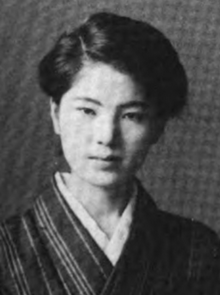Sumie Mishima
Sumie Mishima | |
|---|---|
 Sumie Seo (later Mishima) as a student in the 1920s | |
| Born | Sumie Seo 1900 |
| Died | 1992 |
| Other names | Mishima Sumie, Seo Sumie |
| Occupation(s) | Educator, writer, translator |
Sumie Seo Mishima (1900 – 1992) was a Japanese educator, translator, and writer. She is best known for two memoirs in English, My Narrow Isle (1941) and The Broader Way (1953).
Early life and education
[edit]Seo was born into a samurai-class household near Osaka; her father was a teacher who studied in the United States. After her father died, she lived in her grandfather's household,[1] and then with a paternal aunt in Tokyo.[2] She graduated from Tsuda College, and spent five years in the United States, in part to avoid family pressures to marry.[3][4] She attended Dana Hall School, and Wellesley College in 1927.[5]
Career
[edit]Mishima taught at her alma mater, Tsuda College,[5] and gave private lessons in English.[6] She translated a volume of historical legal documents, and other titles.[5] She worked as a translator for the defense at the war crimes tribunals after World War II.[7]
Mishima wrote two memoirs in English.[8] The first, My Narrow Isle (1941), was reviewed in The Atlantic and The New York Times.[9] Her second memoir, The Broader Way (1953), covered her experiences in Tokyo during and after World War II;[3][10] it was described by one American reviewer as "the most important book to be written in English by a Japanese woman since the end of World War II."[11] An Australian reviewer found it "an intensely personal account of one Japanese housewife's journey through a world war and a revolution in social custom."[7]
In 1942, her Wellesley classmate Ruth Tilford Clowes profiled Mishima as a woman "caught between worlds".[6] Ruth Benedict considered Mishima's My Narrow Isle in The Chrysanthemum and the Sword (1946), and anthropological study of Japanese culture in the mid-twentieth century.[12]
Publications
[edit]- My Narrow Isle: The Story of a Modern Woman in Japan (1941)[13]
- The Broader Way: A Woman's Life in the New Japan (1953)[14]
Personal life
[edit]Seo married Hajime Mishima, a professor of Chinese studies who had four young children from his first marriage.[5][6] She died in 1992, in her nineties.
References
[edit]- ^ Crowe, Mildred R. (August 24, 1941). "Woman Against Japan". Chattanooga Daily Times. p. 47 – via Newspapers.com.
- ^ Woods, Katherine (February 16, 1941). "A Japanese Woman's Changing World: 'My Narrow Isle' is a Personal Record of Unusual Interest". The New York Times Book Review. p. 9.
- ^ a b Kelsky, Karen (2001-11-21). Women on the Verge: Japanese Women, Western Dreams. Duke University Press. pp. 46–50, 75–76. ISBN 978-0-8223-2816-2.
- ^ Shannon, Christopher (2001). A World Made Safe for Differences: Cold War Intellectuals and the Politics of Identity. Rowman & Littlefield. pp. 9–10. ISBN 978-0-8476-9057-2.
- ^ a b c d "Sumie Seo ('27)". Wellesley College. Retrieved 2024-11-15.
- ^ a b c Clowes, Mary Tilford (September 13, 1942). "The Story of Sumie Seo, Caught Between Worlds". The Courier-Journal. p. 28 – via Newspapers.com.
- ^ a b Robinson, Peter (July 17, 1954). "Freedom for Women". The Sydney Morning Herald. p. 16 – via Newspapers.com.
- ^ Robins-Mowry, Dorothy (2019-06-18). The Hidden Sun: Women Of Modern Japan. Routledge. p. 1868. ISBN 978-1-000-30215-8.
- ^ Chamberlin, William Henry (1941-04-01). "My Narrow Isle". The Atlantic. ISSN 2151-9463. Retrieved 2024-11-15.
- ^ Frost, Peter K. (2024-03-28). Nation Building in Japan, 1945–1952: The Allied Occupation and the US-Japan Alliance. Taylor & Francis. ISBN 978-1-040-00439-5.
- ^ "A Vivid Picture of Suffering in Tokyo During and After War". The Lexington Herald. June 7, 1953. p. 39 – via Newspapers.com.
- ^ Benedict, Ruth (2021-11-11). The Chrysanthemum and the Sword. Rare Treasure Editions. ISBN 978-1-77464-443-0.
- ^ Mishima, Sumie Seo. (1941). My narrow isle; the story of a modern woman in Japan. New York: The John Day company.
- ^ Mishima, Sumie Seo. (1971). The broader way; a woman's life in the new Japan. Westport, Conn.: Greenwood Press. ISBN 978-0-8371-5797-9.
External links
[edit]- A portrait of Sumie Mishima in the 1950s, photographed by Clara Sipprell, in the collection of the Amon Carter Museum of American Art
- Sumie Mishima among other Wellesley College alumnae in 1950, from the Wellesley College Japanese Alumnae Corner
